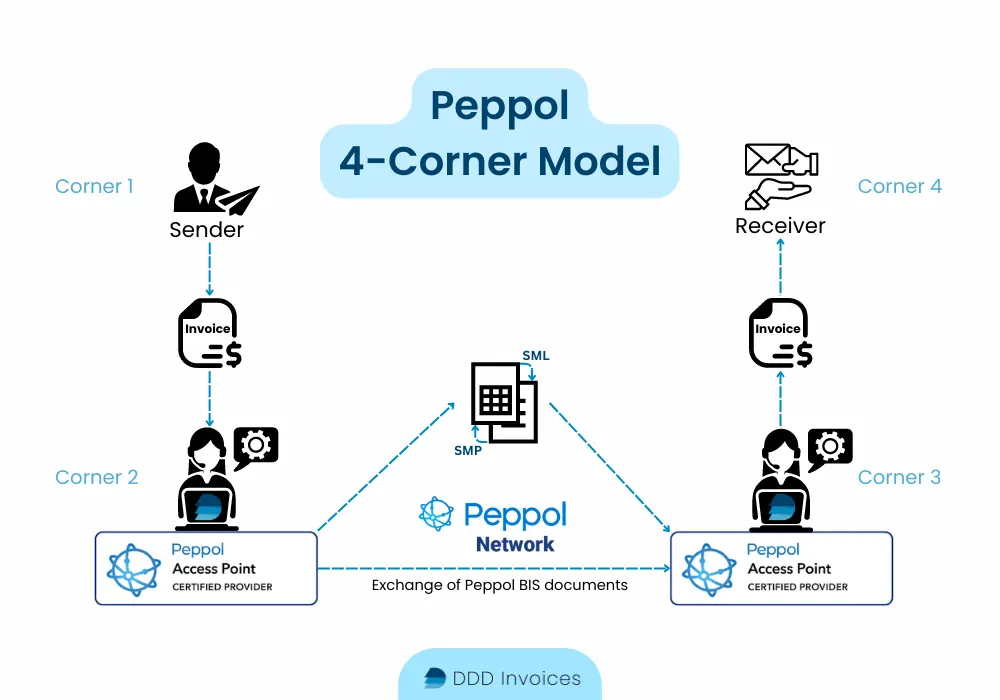
The Peppol Network and Peppol Access Points (Complete Guide)
Last modified on 05 July 2023 in E-invoicing
In the era of digitalization in Europe, Peppol e-invoicing has emerged as a game-changing network. But what exactly is Peppol? How can businesses connect to it? And what sets DDD Invoices apart from other Peppol Service Providers?
Peppol stands for Pan-European Public Procurement Online and is an international interoperability framework that enables the exchange of electronic documents, particularly e-invoices, among businesses and government entities across different countries. Through the support of the European Commission, the use of Peppol has become present in over 30 countries around the world.
Overview of the Peppol Network
From its original goal in 2008 of creating a common framework for sending documents between European governments, the Peppol interoperability framework has become an all-encompassing e-document exchange network. It enables the secure and standardized transfer of sensitive data through its open, interoperable network.
It uses OASIS Universal Business Language (UBL) syntax which is specified by ISO/IEC 19845. Communication is conducted over the Peppol eDelivery Network through a 4-corner model which will be explained further on.
Peppol offers a collection of technological guidelines, protocols, and standards that guarantee the quick and secure exchange of electronic invoices between trade partners. It makes use of a network of Access Points (APs) that serve as middlemen and enables the sending and receiving of electronic invoices. By adhering to requirements, these APs guarantee compatibility and interoperability with various hardware and software.
Peppol is not an e-procurement system in and of itself, but rather supports a variety of business processes by creating and maintaining business documents.
Use of Peppol invoices in Europe
Since 18 April 2020, all public sector institutions (ex. public schools, transport) and authorities in the EU have been mandated to have the capabilities to receive Peppol invoices.
The standardization of invoicing has granted them ease in trading throughout the continent as many national standards have been abandoned. Those who still have their own standards will be gradually replaced by Peppol specifications. Countries outside of the EU have also decided to use the Peppol standard in order to encourage multinational trade such as Montenegro.
Peppol Access Points (APs)
An essential part of the Peppol network infrastructure is an Access Point (AP). It acts as a middleman or gateway to allow suppliers and receivers to exchange electronic documents, especially e-invoices. A certified AP has the main purpose to make it easier for e-invoices to be sent from one organisation to another. The AP serves as a bridge between various business systems and software platforms, converting a sender's e-invoice into a standardized Peppol BIS billing 3.0 format that the recipient's system can understand.
We are a Peppol Service Provider and Access Point for your e-invoicing needs. Schedule a quick chat to learn more!
Peppol BIS Billing
Every network and platform has its own standard and format in which invoices are sent and Peppol Business Interoperability Specifications (BIS) are just that. It acts as a defined framework and blueprint outlining the best standards and structure for arranging information within electronic documents.
4-Corner Model

Corner 1: The e-invoice sender
The process is started by the sender, who could be a company or organization, that uses their own software or business system to create an electronic invoice. The sender's Access Point (AP) serves as a go-between and a point of connection to the Peppol network.
Corner 2: Conversion and validation at a sender's Access Point
The e-invoice is transformed into a standardized format that complies with Peppol requirements via the sender's AP. It verifies the invoice data to ensure accuracy and compliance with the necessary requirements. This procedure assures consistency in the invoice structure and the limitation of errors.
Corner 3: Processing at the receivers Access Point
The recipient's Access Point receives the standard e-invoice via a secure transmission from the sender's AP. Encryption and other security measures may be used during the transmission process to safeguard the data's confidentiality and integrity.
The recipient's AP then checks and processes the e-invoice after receiving it. This is done to confirm the data's validity and integrity as well as compliance with the Peppol framework. The invoice is additionally converted by the recipient's AP into a format appropriate for the recipient's software, ERP or CRM.
Corner 4: Delivery to the recipient
The approved and converted electronic invoice is sent to the intended recipient's business system or software via the recipient's AP. The e-invoice is subsequently processed by the recipient inside of their own system, enabling additional activities including invoice approval, payment processing, and record-keeping.
Peppol Directory
The directory is similar to the Yellow Pages where it identifies recipients and informs the user about what processes they support and who their AP provider is. This can also be helpful to find an entity's Peppol ID which can be used to automatically identify a user and limit ghost invoices and data input errors.
Access the Peppol Directory here.
Local Peppol Authorities
Countries that implement Peppol have the choice of either abiding by the OpenPeppol requirements or creating a local Peppol Authority (PA). This has the benefit of a country tailoring the solution to its needs and improving its overview of regional e-document transfer.
18 countries have chosen this route and have created either their own document types, mandated registration through a specific service metadata publisher (SMP) or other deviations. They then can advocate for the interests and specifications of their region they would like to change or add to the Peppol network.
Benefits of Peppol
Cost savings and increased efficiency
Peppol makes it simple to onboard clients and suppliers, eliminating the need to integrate several systems and processes or enter into bilateral e-invoicing agreements. Peppol incorporates numerous electronic procurement procedures without any difficulty, going beyond being only an e-invoicing network. There are significant cost savings as a result of the increased efficiency and the elimination of roaming fees for document transfers.
Compliance, Improved security and reduced errors
Issuing invoices through this network ensures that they are compliant with changing invoicing rules every time. The e-delivery network, in combination with Peppol APs, makes for a very secure system, especially compared to mailing physical invoices. Invoice data input is also automated making the data less prone to errors.
Streamlined procurement processes
Since invoices and documents arrive instantaneously, invoices are settled much sooner than traditional invoices. This has an overall positive effect on cash flow and limits miscommunication between trading partners.
Ready to experience the benefits of e-invoicing and Peppol firsthand? Schedule a demo with our Peppol experts.
DDD Invoices: a certified Peppol Service Provider
Want to connect to Peppol and don't know how? Here are the benefits of choosing DDD Invoices as your access point:
-
Unlock the ability to send and receive e-documents around the world, without worrying about local compliance issues. Through our API, we automatically fill in your invoice data and send the invoice to the proper authorities, letting you focus on your core business processes and we manage the bureaucracy.
-
Seamlessly integrate into your current invoicing system, ERP or CRM in as little as one day. Enjoy an error-free and automated invoicing process through our secure and reliable service.
Want to connect to the Peppol network? Contact our team to learn more.
FAQs about Peppol
How does Peppol work?
What are the benefits of using Peppol for e-invoice and e-document exchange?
Peppol offers advantages for those connected to the network including standardized formats, seamless communication between enterprises, and access to a large network of trading partners for e-invoice and e-document transmission.
Automating procedures lowers costs, increases operational effectiveness and improves data accuracy through organized formats. Invoicing via Peppol provides a variety of businesses to streamline document interexchange, reduce time and increase interoperability, especially in cross-border trade.How can I connect to the Peppol network?
Businesses are able to access the Peppol network by working with registered Peppol Access Points (APs). They then link your company to the network by enabling the sending of e-invoices. In order to receive them, a unique Peppol ID must be obtained.
You're in luck! DDD Invoices is a trusted Peppol Access Point provider and can assist you in meeting your invoicing requirements. Learn more here."Ready to save on development costs?"
Unlock globally compliant e-invoicing with a single API
- Overview of the Peppol Network
- Use of Peppol invoices in Europe
- Peppol Access Points (APs)
- Peppol BIS Billing
- 4-Corner Model
- Corner 3: Processing at the receivers Access Point
- Corner 4: Delivery to the recipient
- Peppol Directory
- Local Peppol Authorities
- Benefits of Peppol
- DDD Invoices: a certified Peppol Service Provider
- FAQs about Peppol
"Ready to save on development costs?"
Unlock globally compliant e-invoicing with a single API